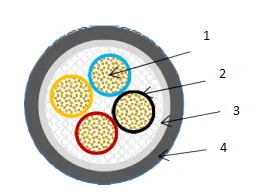11 月 . 01, 2024 06:19 Back to list
Understanding the Basics of Electric Cable Wiring and Its Applications in Modern Installations
Understanding Electric Cables An Essential Component of Modern Infrastructure
Electric cables are an indispensable part of modern life, playing a crucial role in the distribution of electricity from power sources to homes, businesses, and industries. These wires are designed to conduct electricity safely and efficiently, ensuring that our electrical systems function reliably. With the rapid advancement of technology and the growing demand for electricity, understanding the nuances of electric cables has become increasingly important.
Types of Electric Cables
Electric cables can be categorized based on their construction, application, and the type of conductor they use. The most common types include
1. Single-Core Cables These cables consist of a single conductor and are typically used in low-voltage applications. They are easy to install and are suitable for straightforward wiring needs.
2. Multi-Core Cables These cables contain multiple conductors, allowing for more complex wiring configurations. They are often used in situations where flexibility and versatility are required, such as in industrial settings and complex electrical installations.
3. Flexible Cables Designed to withstand repeated bending and movement, flexible cables are used in portable devices and equipment. They are made with numerous thin strands of wire that make them pliable and durable.
4. Armoured Cables These are designed with an additional layer of protection to withstand mechanical damage. They are typically used in outdoor and industrial applications where exposure to harsh environments is a concern.
5. Low-Voltage Cables Used for applications such as lighting and surveillance systems, low-voltage cables are designed to carry less than 1000 volts and are crucial for safety in residential installations.
electric cable wire

Materials Used in Electric Cables
The materials used in electric cables significantly influence their performance. The most common materials include
- Copper The most widely used conductor due to its excellent conductivity and flexibility. Copper cables are commonly found in residential and commercial installations.
- Aluminum While less conductive than copper, aluminum is lighter and more cost-effective. It is used in overhead power lines and some residential applications.
- Insulation Material The insulation around conductors can be made from various materials such as PVC, XLPE (cross-linked polyethylene), and rubber. The choice of insulation is crucial for ensuring safety and durability, as it prevents electrical leakage and protects against environmental hazards.
The Importance of Cable Ratings
Electric cables are rated based on their voltage capacity, current-carrying capacity, and temperature limits. Understanding these ratings is essential for selecting the right cable for a specific application. Using a cable that does not meet the required specifications can lead to overheating, electrical failures, or even fires.
Conclusion
As technology continues to evolve and the demand for power increases, the importance of electric cables cannot be overstated. They are not just wires; they are lifelines that power our everyday activities—from turning on lights to running complex machinery. Whether for residential, commercial, or industrial use, understanding the types, materials, and ratings of electric cables is essential for ensuring safety, efficiency, and reliability in our electrical systems. As we advance toward a more electrified future, proper selection and installation of electric cables will be critical in supporting our growing energy needs.
Share
-
Understanding the Differences Between Wafer Type Butterfly Valve and Lugged Butterfly ValveNewsOct.25,2024
-
The Efficiency of Wafer Type Butterfly Valve and Lugged Butterfly ValveNewsOct.25,2024
-
The Ultimate Guide to Industrial Swing Check Valve: Performance, Installation, and MaintenanceNewsOct.25,2024
-
Superior Performance with Industrial Swing Check Valve: The Essential Valve for Any SystemNewsOct.25,2024
-
Industrial Swing Check Valve: The Ideal Solution for Flow ControlNewsOct.25,2024
-
You Need to Know About Industrial Swing Check Valve: Functionality, Scope, and PerformanceNewsOct.25,2024